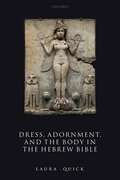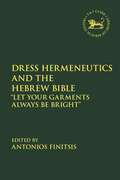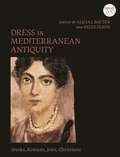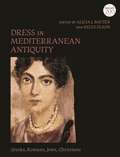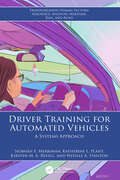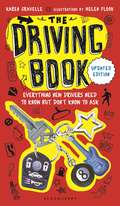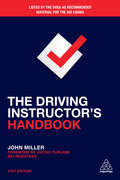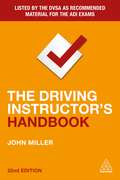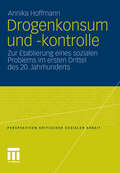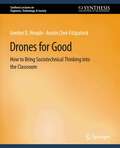- Table View
- List View
Dress, Adornment, and the Body in the Hebrew Bible
by Laura QuickDress, Adornment, and the Body in the Hebrew Bible is the first monograph to treat dress and adornment in biblical literature in the English language. It moves beyond a description of these aspects of ancient life to encompass notions of interpersonal relationships and personhood that underpin practices of dress and adornment. Laura Quick explores the ramifications of body adornment in the biblical world, informed by a methodologically plural approach incorporating material culture alongside philology, textual exegesis, comparative evidence, and sociological models. Drawing upon and synthesizing insights from material culture and texts from across the eastern Mediterranean, the volume reconstructs the social meanings attached to the dressed body in biblical texts. It shows how body adornment can deepen understanding of attitudes towards the self in the ancient world. In Quick's reconstruction of ancient performances of the self, the body serves as the observed centre in which complex ideologies of identity, gender, sexuality, ethnicity, and social status are articulated. The adornment of the body is thus an effective means of non-verbal communication, but one which at the same time is controlled by and dictated through normative social values. Exploring dress, adornment, and the body can therefore open up hitherto unexplored perspectives on these social values in the ancient world, an essential missing piece in understanding the social and cultural world which shaped the Hebrew Bible.
Dress and Clothing in the Hebrew Bible: “For All Her Household Are Clothed in Crimson” (The Library of Hebrew Bible/Old Testament Studies #679)
by Antonios FinitsisBuilt upon the flourishing study of costume, this book analyses sartorial evidence provided both by texts of the ancient Near East and the Hebrew Bible. The essays within lend clarity to the link between material and ideological, examining the tradition of dress, the different types of literature that reference the tradition of garments, and the people for whom such literature was written. The contributors explore sources that illuminate the social, psychological, aesthetic, ideological and symbolic meanings of clothing. The topics covered range from the relationship between clothing, kingship and power, to the symbolic significance of the high priestly regalia and the concept of garments as deception and defiance, while also considering the tendency to omit or ignore descriptions of YHWH's clothing. Following a historical sequence, the essays cross-reference with each other to create a milestone in biblical sartorial study.
Dress and Clothing in the Hebrew Bible: “For All Her Household Are Clothed in Crimson” (The Library of Hebrew Bible/Old Testament Studies)
Built upon the flourishing study of costume, this book analyses sartorial evidence provided both by texts of the ancient Near East and the Hebrew Bible. The essays within lend clarity to the link between material and ideological, examining the tradition of dress, the different types of literature that reference the tradition of garments, and the people for whom such literature was written. The contributors explore sources that illuminate the social, psychological, aesthetic, ideological and symbolic meanings of clothing. The topics covered range from the relationship between clothing, kingship and power, to the symbolic significance of the high priestly regalia and the concept of garments as deception and defiance, while also considering the tendency to omit or ignore descriptions of YHWH's clothing. Following a historical sequence, the essays cross-reference with each other to create a milestone in biblical sartorial study.
Dress Hermeneutics and the Hebrew Bible: "Let Your Garments Always Be Bright" (The Library of Hebrew Bible/Old Testament Studies)
Antonios Finitsis and contributors continue their examination of dress and clothing in the Hebrew Bible in this collection of illuminating essays. Straddling the divide between the material and the ideological, this book lends shape and texture to topics including social standing, agency, and the motif of cloth and clothing in Esther. Essays also explore the function of dress metaphors in imprecatory Psalms, the symbolic function of headdresses, and the divine clothing of Adam and Eve and the hermeneutics of trauma recovery. Together, the contributors continue to shape scholarly discourse on a growing body of scholarship on dress in the Bible.By turning their analytical gaze to this primary evidence, the contributors are able to reveal the social, psychological, aesthetic, ideological and symbolic meanings of dress in the Hebrew Bible, thereby producing insights into the literature and cultural world of the ancient Near East.
Dress in Mediterranean Antiquity: Greeks, Romans, Jews, Christians
by Alicia J. Batten and Kelly OlsonInsights from anthropology, religious studies, biblical studies, sociology, classics, and Jewish studies are here combined to provide a cutting-edge guide to dress and religion in the Greco-Roman World and the Mediterranean basin. Clothing, jewellery, cosmetics, and hairstyles are among the many aspects examined to show the variety of functions of dress in communication and in both establishing and defending identity. The volume begins by reviewing how scholars in the fields of classics, anthropology, religious studies, and sociology examine dress. The second section then looks at materials, including depictions of clothing in sculpture and in Egyptian mummy portraits. The third (and largest) part of the book then examines dress in specific contexts, beginning with Greece and Rome and going on to Jewish and Christian dress, with a specific focus on the intersection between dress, clothing and religion. By combining essays from over twenty scholars from different disciplinary backgrounds, the book provides a unique overview of different approaches to and contexts of dress in one volume, leading to a greater understanding of dress both within ancient societies and in the contemporary world.
Dress in Mediterranean Antiquity: Greeks, Romans, Jews, Christians
by Alicia J. Batten Kelly OlsonInsights from anthropology, religious studies, biblical studies, sociology, classics, and Jewish studies are here combined to provide a cutting-edge guide to dress and religion in the Greco-Roman World and the Mediterranean basin. Clothing, jewellery, cosmetics, and hairstyles are among the many aspects examined to show the variety of functions of dress in communication and in both establishing and defending identity. The volume begins by reviewing how scholars in the fields of classics, anthropology, religious studies, and sociology examine dress. The second section then looks at materials, including depictions of clothing in sculpture and in Egyptian mummy portraits. The third (and largest) part of the book then examines dress in specific contexts, beginning with Greece and Rome and going on to Jewish and Christian dress, with a specific focus on the intersection between dress, clothing and religion. By combining essays from over twenty scholars from different disciplinary backgrounds, the book provides a unique overview of different approaches to and contexts of dress in one volume, leading to a greater understanding of dress both within ancient societies and in the contemporary world.
Dressing - General Hints and Tips (CFVI Resource)
by Guide DogsGuidance focusing on 'Dressing - General Hints and Tips'. CFVI Area 6. Habilitation: Independent Living Skills Resource Type: Instruction Guide for independent living skills
Drifting - Architecture and Migrancy (Architext)
by Stephen CairnsTo dwell in these globalizing times requires us to negotiate increasingly palpable flows - of capital, ideas, images, goods, technology, and people. Such flows seem to pressurize, breach and sometimes even disaggregate the places we always imagined to be distinctive and stable. This book is focussed on the interaction of two elements within this contemporary situation. The first is the very idea of a place we imagine to be distinctive and stable. This idea is explored through architecture, the institution that in the West has claimed the responsibility for imagining and producing places along these lines. The second element is a particular kind of global flow, namely the human flows of immigrants, refugees, exiles, guestworkers and other migrant groups. This book carefully inspects the intersections between architectures of place and flows of migrancy. It does so without seeking to defend the idea of place, nor lament its passing. Rather this book is an exploration of the often complex and unorthodox modes of dwelling that are emerging precisely from within the ruins of the idea of place. This exploration is informed by critical analyses of architecture and urbanism, and their representation in media such as film.The book is animated empirically by a set of overlapping and intersecting trajectories that shift from Hong Kong to Canada, Australia and Germany; from Southern Europe to Australia; from Britain to India, Canada and New Zealand; from Southeast Asia, to the Pacific Islands, to New Zealand; and from Latin America and East Asia to the United States. But each geographical context discussed represents only one point within a wider pattern of movement that implicates other localities, and so signals the very undoing of a unified geographical logic.
Drifting - Architecture and Migrancy (Architext)
by Stephen CairnsTo dwell in these globalizing times requires us to negotiate increasingly palpable flows - of capital, ideas, images, goods, technology, and people. Such flows seem to pressurize, breach and sometimes even disaggregate the places we always imagined to be distinctive and stable. This book is focussed on the interaction of two elements within this contemporary situation. The first is the very idea of a place we imagine to be distinctive and stable. This idea is explored through architecture, the institution that in the West has claimed the responsibility for imagining and producing places along these lines. The second element is a particular kind of global flow, namely the human flows of immigrants, refugees, exiles, guestworkers and other migrant groups. This book carefully inspects the intersections between architectures of place and flows of migrancy. It does so without seeking to defend the idea of place, nor lament its passing. Rather this book is an exploration of the often complex and unorthodox modes of dwelling that are emerging precisely from within the ruins of the idea of place. This exploration is informed by critical analyses of architecture and urbanism, and their representation in media such as film.The book is animated empirically by a set of overlapping and intersecting trajectories that shift from Hong Kong to Canada, Australia and Germany; from Southern Europe to Australia; from Britain to India, Canada and New Zealand; from Southeast Asia, to the Pacific Islands, to New Zealand; and from Latin America and East Asia to the United States. But each geographical context discussed represents only one point within a wider pattern of movement that implicates other localities, and so signals the very undoing of a unified geographical logic.
Driven by Data 2.0: A Practical Guide to Improve Instruction
by Paul Bambrick-SantoyoThe bestselling guide for school leaders—updated in a new edition Data-driven instruction is the philosophy that schools should focus on two simple questions: how do you know if are students learning? And when they are not, what do you do about it? Driven by Data 2.0 is a practical guide that answers these questions to empower schools to achieve significant gains in student achievement. Rooted in a proven framework that has been implemented in thousands of schools, the book presents what makes schools successful along with tools to put the framework into place to make data work for your schools: Assess—set the roadmap for learning Analyze—identify why students struggle Act—teach more effectively what students need Build the culture—train and develop your staff so that data-driven instruction can thrive If you’re a K – 12 leader, coach, or teacher looking to implement data-driven instruction in your school district, Driven by Data 2.0 has the tools to train your staff: PD materials, videos of exemplar practice and all the resources you need to achieve remarkable results.
Driven by Data 2.0: A Practical Guide to Improve Instruction
by Paul Bambrick-SantoyoThe bestselling guide for school leaders—updated in a new edition Data-driven instruction is the philosophy that schools should focus on two simple questions: how do you know if are students learning? And when they are not, what do you do about it? Driven by Data 2.0 is a practical guide that answers these questions to empower schools to achieve significant gains in student achievement. Rooted in a proven framework that has been implemented in thousands of schools, the book presents what makes schools successful along with tools to put the framework into place to make data work for your schools: Assess—set the roadmap for learning Analyze—identify why students struggle Act—teach more effectively what students need Build the culture—train and develop your staff so that data-driven instruction can thrive If you’re a K – 12 leader, coach, or teacher looking to implement data-driven instruction in your school district, Driven by Data 2.0 has the tools to train your staff: PD materials, videos of exemplar practice and all the resources you need to achieve remarkable results.
Driver Training for Automated Vehicles: A Systems Approach (ISSN)
by Siobhán E. Merriman Katherine L. Plant Kirsten M. Revell Neville A. StantonSince the introduction of Automated Vehicles (AVs) on roads, there have been a number of high-profile collisions, which have highlighted significant driver challenges. These include challenges associated with drivers’ trust in the automation, their knowledge and awareness of the AV’s capabilities and limitations and their reduced situation awareness of the road environment and the vehicle. Solutions are needed to overcome these challenges, so that the expected benefits of AVs can be realised.Driver Training for Automated Vehicles: A Systems Approach identifies the training requirements for drivers of AVs and takes a systematic approach to design, develop, implement and evaluate a comprehensive training package to address these requirements. This book explores how training can overcome the driver challenges associated with AVs by improving drivers’ mental models, trust in automation, decisions and behaviour when activating a Level 4 AV. It presents a systematic approach to the training lifecycle, by first presenting the current state of research into AVs, identifying the challenges and training requirements for drivers of AVs, and then developing and evaluating a training programme to achieve these requirements. This fascinating title highlights the need for drivers to undergo training for AVs, and takes us a step closer to this need. It walks readers through a systematic, four-step process and provides practical guidance to develop and evaluate an effective training programme. The reader will develop a thorough understanding of the current driver challenges with AVs and the methods and systems to mitigate them through current knowledge and research.This book is an ideal read for practitioners, designers and academics with a professional or research interest in AVs. Its appeal extends to those in the fields of automotive design, Systems Engineering, Human Factors and education and training.
Driver Training for Automated Vehicles: A Systems Approach (ISSN)
by Siobhán E. Merriman Katherine L. Plant Kirsten M. Revell Neville A. StantonSince the introduction of Automated Vehicles (AVs) on roads, there have been a number of high-profile collisions, which have highlighted significant driver challenges. These include challenges associated with drivers’ trust in the automation, their knowledge and awareness of the AV’s capabilities and limitations and their reduced situation awareness of the road environment and the vehicle. Solutions are needed to overcome these challenges, so that the expected benefits of AVs can be realised.Driver Training for Automated Vehicles: A Systems Approach identifies the training requirements for drivers of AVs and takes a systematic approach to design, develop, implement and evaluate a comprehensive training package to address these requirements. This book explores how training can overcome the driver challenges associated with AVs by improving drivers’ mental models, trust in automation, decisions and behaviour when activating a Level 4 AV. It presents a systematic approach to the training lifecycle, by first presenting the current state of research into AVs, identifying the challenges and training requirements for drivers of AVs, and then developing and evaluating a training programme to achieve these requirements. This fascinating title highlights the need for drivers to undergo training for AVs, and takes us a step closer to this need. It walks readers through a systematic, four-step process and provides practical guidance to develop and evaluate an effective training programme. The reader will develop a thorough understanding of the current driver challenges with AVs and the methods and systems to mitigate them through current knowledge and research.This book is an ideal read for practitioners, designers and academics with a professional or research interest in AVs. Its appeal extends to those in the fields of automotive design, Systems Engineering, Human Factors and education and training.
Drivers and Barriers to Achieving Quality in Higher Education
by Heather EgginsThe topic of achieving and assuring quality in every higher education institution continues to be both relevant and urgent worldwide. This volume presents a considered discussion of a range of facets of the issue, drawing on the findings of a 3 year EU research programme involving seven countries: Czech Republic, United Kingdom, Latvia, Portugal, Poland, Slovakia and the Netherlands. Topics include access, student assessment, governance, stakeholders, academic faculty, information and the interface between the secondary and tertiary sectors. The authors, all of whom are drawn from the research teams, explore particular aspects of the research objectives. These aim to identify the drivers and overcome the barriers to establishing high quality in both European higher education, in relation to the Standards and Guidelines for Quality Assurance and, by implication, in worldwide higher education.
The Driving Book: Everything New Drivers Need to Know but Don't Know to Ask
by Karen Gravelle Helen FlookEven after taking Driver's Ed and passing that dreaded road test, there are so many things new drivers need to learn about the practical aspects of driving that will only come from experience. Handing over the keys is a traumatic rite of passage for parents, and they will sleep better knowing that The Driving Book is in their teens' glove compartments. Covering virtually every scenario a new driver may face, from changing a tire to negotiating privileges with parents to handling a car in bad weather, Karen Gravelle helps teen drivers navigate through tricky new territory-on the road and at home.
Driving Change Through Diversity and Globalization: Transformative Leadership in the Academy
by James A. AndersonThis book significantly advances discussion of the mission of higher education in today’s multicultural environment and global economy. It sets out the challenges and considerations that must be addressed by administrative leaders, by trustees, and others who shape the vision and direction of the institution – but most particularly by academic deans and faculty.The author makes the case that the inclusion of diversity and globalization in disciplinary work contributes to the research agendas of individual faculty and their departments, aligns with scholarly values, and promotes such student learning goals as tolerance of ambiguity and paradox, critical thinking and creativity. He offers a strategic vision of success, backed by theory and examples of effective application, for creating transformative change; and provides a roadmap to implementing inclusive pedagogical practices and curricula. With implementation dependent on leadership and participation at every level of an institution, everyone with a stake in its future should read this book.
Driving Change Through Diversity and Globalization: Transformative Leadership in the Academy
by James A. AndersonThis book significantly advances discussion of the mission of higher education in today’s multicultural environment and global economy. It sets out the challenges and considerations that must be addressed by administrative leaders, by trustees, and others who shape the vision and direction of the institution – but most particularly by academic deans and faculty.The author makes the case that the inclusion of diversity and globalization in disciplinary work contributes to the research agendas of individual faculty and their departments, aligns with scholarly values, and promotes such student learning goals as tolerance of ambiguity and paradox, critical thinking and creativity. He offers a strategic vision of success, backed by theory and examples of effective application, for creating transformative change; and provides a roadmap to implementing inclusive pedagogical practices and curricula. With implementation dependent on leadership and participation at every level of an institution, everyone with a stake in its future should read this book.
The Driving Instructor's Handbook: A Reference And Training Manual
by John MillerNow in its 21st edition, The Driving Instructor's Handbook is widely recognized in the driver training industry as the authoritative reference guide for both trainee and qualified instructors and is listed by the Driver and Vehicle Standards Agency (DVSA) as recommended reading for the Approved Driving Instructor (ADI) exams.This best-selling text covers every aspect of the profession, from the role itself, to the characteristics needed to do the job effectively through the preparation for the three ADI exams (theory and hazard perception, driving ability and instructional ability). The Driving Instructor's Handbook also includes detailed guidance on issues such as licences, training, teaching and coaching skills and road traffic law and covers all 2016/17 changes to the ADI examinations and standards checks, including the most recent essential updates from late 2017. This handbook is essential reading for anyone involved in the training of drivers and instructors at all levels and will ensure that new drivers are better able to cope with the increasing demands made on them.
The Driving Instructor's Handbook
by John MillerNow in its 21st edition, The Driving Instructor's Handbook is widely recognized in the driver training industry as the authoritative reference guide for both trainee and qualified instructors and is listed by the Driver and Vehicle Standards Agency (DVSA) as recommended reading for the Approved Driving Instructor (ADI) exams.This best-selling text covers every aspect of the profession, from the role itself, to the characteristics needed to do the job effectively through the preparation for the three ADI exams (theory and hazard perception, driving ability and instructional ability). The Driving Instructor's Handbook also includes detailed guidance on issues such as licences, training, teaching and coaching skills and road traffic law and covers all 2016/17 changes to the ADI examinations and standards checks, including the most recent essential updates from late 2017. This handbook is essential reading for anyone involved in the training of drivers and instructors at all levels and will ensure that new drivers are better able to cope with the increasing demands made on them.
The Driving Instructor's Handbook
by John MillerRecognized by the Driver and Vehicle Stands Agency (DVSA) as recommended reading for the Approved Driving Instructor (ADI) exams, this bestselling guide is the authoritative guide for both trainee and qualified driving instructors. The Driving Instructor's Handbook covers every aspect of being a driving instructor, from the role itself, to the characteristics needed to the job effectively, through to preparation for the ADI exams. Now in its 22nd edition, the book includes detailed guidance on issues such as licences, training, teaching and coaching skills and road traffic law. Fully updated to cover all changes including updates to the ADI theory and practical tests, new rules in the Highway Code, revised motorway legislation, different rules and procedures in Northern Ireland and updated advice on disabilities, this book is essential reading for anyone involved in the training of drivers or driving instructors.
Driving Performance through Learning: Develop Employees through Effective Workplace Learning
by Andy LancasterLearning and Development (L&D) professionals are uniquely placed in an organization to improve both individual employee performance as well as the overall performance of the business. To maximise the impact of learning, activities must be aligned with the goals of the organization and delivered in the flow of work so that performance improvement is continuous. The course can no longer be the default learning option and creative workplace solutions are now vital. Driving Performance through Learning shows L&D professionals how to identify business needs and leverage learning that drives performance improvement to enable an organization to achieve its objectives. Beginning with an exploration of the fast-changing organizational learning landscape Driving Performance through Learning covers everything from how to diagnose needs through performance consulting conversations, using data and metrics and tracking impact to designing agile solutions by leveraging technology, facilitating social collaboration and vibrant learning communities. There is also expert guidance on curating content, embedding coaching, valuing mistakes and adopting a more self-directed learning approach. This book also defines the key characteristics of the new learning organization and the emerging roles of the future-focussed L&D team and whether these new responsibilities should be developed in-house or outsourced. This is an essential handbook for all L&D professionals seeking to transform workplace learning and drive organizational performance.
Driving Performance through Learning: Develop Employees through Effective Workplace Learning
by Andy LancasterLearning and Development (L&D) professionals are uniquely placed in an organization to improve both individual employee performance as well as the overall performance of the business. To maximise the impact of learning, activities must be aligned with the goals of the organization and delivered in the flow of work so that performance improvement is continuous. The course can no longer be the default learning option and creative workplace solutions are now vital. Driving Performance through Learning shows L&D professionals how to identify business needs and leverage learning that drives performance improvement to enable an organization to achieve its objectives. Beginning with an exploration of the fast-changing organizational learning landscape Driving Performance through Learning covers everything from how to diagnose needs through performance consulting conversations, using data and metrics and tracking impact to designing agile solutions by leveraging technology, facilitating social collaboration and vibrant learning communities. There is also expert guidance on curating content, embedding coaching, valuing mistakes and adopting a more self-directed learning approach. This book also defines the key characteristics of the new learning organization and the emerging roles of the future-focussed L&D team and whether these new responsibilities should be developed in-house or outsourced. This is an essential handbook for all L&D professionals seeking to transform workplace learning and drive organizational performance.
Driving Test Tips
by Andrew AdamsDon't let preparing for your driving test drive you up the wall! With tips from instructors and new drivers for both before and during the test, this little book is jam-packed with helpful advice to make sure that you are in fine form for the open road… and that you lose your L-plates rather than your cool.
Drogenkonsum und -kontrolle: Zur Etablierung eines sozialen Problems im ersten Drittel des 20. Jahrhunderts (Perspektiven kritischer Sozialer Arbeit)
by Annika HoffmannVerbreiteter Drogenkonsum gehört in das populäre und wissenschaftliche Bild der Weimarer Republik: Es heißt, in den 1920er Jahren habe eine 'Drogenwelle' Deutschland überrollt. Annika Hoffmann zeigt, wie sich zu Beginn des 20. Jahrhunderts die Deutung des nicht-medizinischen Konsums von Opiaten und Kokain als soziales Problem etablierte und welche Folgen dies für die Konsumenten hat. Die Autorin setzt sich intensiv mit historischen Quellen auseinander und zeigt am problematisierenden Diskurs der Zeitgenossen, wie sich der heute hegemoniale Blick auf Drogen entwickelte und welche Schlussfolgerungen daraus für den Umgang mit Drogen und ihren Konsumenten heute gezogen werden können.
Drones for Good: How to Bring Sociotechnical Thinking into the Classroom (Synthesis Lectures on Engineers, Technology, & Society)
by Gordon D. Hoople Austin Choi-FitzpatrickWhat in the world is a social scientist doing collaborating with an engineer, and an engineer with a sociologist, and together on a book about drones and sociotechnical thinking in the classroom? This book emerges from a frustration that disciplinary silos create few opportunities for students to engage with others beyond their chosen major. In this volume, Hoople and Choi-Fitzpatrick introduce a sociotechnical approach to truly interdisciplinary education around the exciting topic of drones. The text, geared primarily at university faculty, provides a hands-on approach for engaging students in challenging conversations at the intersection of technology and society. Choi-Fitzpatrick and Hoople provide a turnkey solution complete with detailed lesson plans, course assignments, and drone-based case studies. They present a modular framework, describing how faculty might adopt their approach for any number of technologies and class configurations.
